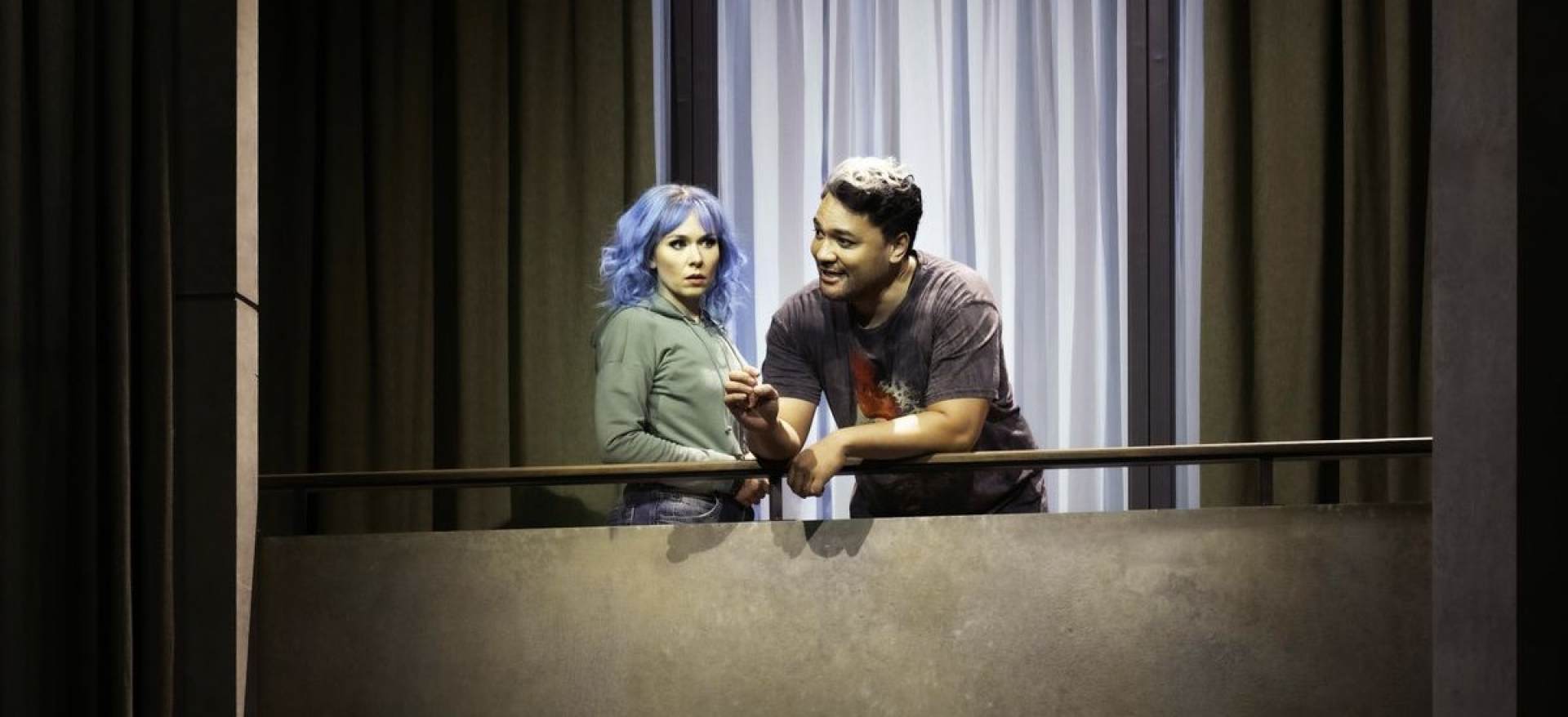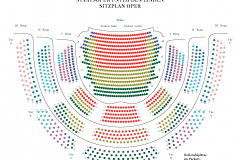Romeo and Juliet
Mo | Tu | We | Th | Fr | Sa | Su |
Romeo and Juliet
Drame lyrique in five parts (1867)
Music from Charles Gounod
Text from Jules Barbier and Michel Carré after William Shakespeare
Duration: approx. 3h, including one interval
Language: French, with German and English surtitles
Recommended age: 12 years and older
The most famous lovers ever: virtually mythical figures, Romeo and Juliette from Shakespeare’s eponymous drama have dominated world literature ever since its premiere in 1597. Among the many musical settings of the work, Charles Gounod’s Roméo et Juliette is one of the most performed. It was a triumphant success already at its premiere as part of the 1867 Paris Exposition. Gounod focuses particularly on the emotional life of the two lovers, for whom he composes no fewer than four love duets. At the same time, he also explores the social context of their forbidden love in the form of powerful choral tableaux and a large fight scene between the enemy families. In this production, director Mariame Clément will place the focus on the youth of the title characters, presenting them not as an exaggerated ideal of a couple, but as young people of today who find their way to another despite all odds.
Plot
Prologue
Once upon a time, there was a story of two lovers from enemy families ...
First Act
The Capulets celebrate the birthday of their daughter Juliette. Secretly disguised in costume, several members of the Montaigu family, enemies of the Capulets, have mixed in with the hosting family. One of them is Roméo, who is immediately struck by Juliette’s beauty. Unaware who she is, he speaks to her and confesses his affection. Juliette’s cousin Tybalt soon realizes that the Montaigus are present. As Tybalt swears revenge, the Montaigus leave the party.
Second Act
Roméo returns to the house of the Capulets to see Juliette again. He witnesses a monologue in which Juliette admits that she has also fallen in love with him. When both declare their love for one another, they are interrupted by a group of Capulets who have followed Roméo. When they leave, Juliette asks Roméo to let her know the next morning when and where they can marry.
Third Act
Roméo and Juliette ask Frère Laurent to marry them. The priest hopes in this way to put an end to the feud between the Capulets and the Montaigus. He solemnly celebrates the marriage ceremony.
Roméo’s friend Stéphano provokes the Capulets with a mocking song, triggering a brawl between the Capulets and the Montaigus. Roméo tries to keep the two families apart, but is forced to witness how Tybalt kills his friend Mercutio. Roméo loses control and avenges Mercutio’s death by killing Tybalt. The public skirmish comes to the attention of the Duke of Verona, who casts judgement on Roméo: for killing Tybalt, he is banished from the city.
Fourth Act
Roméo and Juliette spend their wedding night together, only separated by the approach of dawn. After Roméo’s departure, Juliette learns from her father that Tybalt’s last wish was that she marry Count Pâris. In desperation, Juliette asks Frère Laurent for help. He suggests drinking a potion that will put her to a death-like sleep right before the forced wedding. He promises to make sure that Roméo will return and, as soon as she awakes, escape with her. Juliette trusts him, takes the potion and collapses before the eyes of her family, apparently dead.
Fifth Act
Roméo has learned of Juliette’s death. Since he cannot live without her, he poisons himself. In that very moment, Juliette awakes from her unconsciousness. They fall into one another’s arms and recall the happy hours of their love before they leave this
Program and cast
Musical Director: Francesco Ivan Ciampa
Director: Mariame Clément
Set and Costume Design: Julia Hansen
Lighting: Ulrik Gad
Stunt Coordination: Ran Arthur Braun
Chorus Master: Gerhard Polifka
Juliette: Lisette Oropesa
Gertrude: Katharina Kammerloher
Tybalt: Maciej Kwaśnikowski
Pâris: Irakli Pkhaladze
Capulet: Arttu Kataja
Grégorio: Dionysios Avgerinos
Roméo: Charles Castronovo
Stéphano: Rebecka Wallroth
Mercutio: Jaka Mihelač
Benvolio: Andrés Moreno García
Friar Laurence: Renato Girolami
The Duke: Hanseong Yun
State Opera Chorus, Berlin State Orchestra
State Opera Unter den Linden
Staatsoper Unter den Linden is one of Berlin's most prestigious opera houses, with a rich history and significant cultural impact.
History:
The Staatsoper Unter den Linden was originally built between 1741 and 1743, under the direction of architect Georg Wenzeslaus von Knobelsdorff. It was commissioned by Frederick II of Prussia and was initially named the Königliche Oper (Royal Opera). The opera house has undergone several renovations and reconstructions, notably after World War II damage. It reopened in 1984, following a major renovation.
Construction:
The original design was characterized by its Baroque style, featuring an elegant façade and a grand entrance. The building was reconstructed in the 1950s and 1980s, maintaining its classical exterior while modernizing the interior. The façade features a classic portico with six Corinthian columns and a prominent central pediment.
Interior:
The interior is known for its opulent and classical design. The auditorium is renowned for its acoustics and grandeur, with luxurious velvet seats and elaborate decorations. The stage and seating areas have been updated to meet modern performance standards while preserving historical aesthetics.
Concerts and Performances:
The Staatsoper Unter den Linden hosts a variety of performances, including operas, orchestral concerts, and ballet. It is home to the Staatskapelle Berlin, one of Germany's leading orchestras. The opera house is celebrated for its high-quality productions and its role in Berlin’s vibrant cultural scene.
JOURNEY
The Staatsoper Unter den Linden has completely barrier-free access due to its excellent public transport connections.
ADDRESS: Unter den Linden 7; 10117 Berlin
SUBURBAN RAILWAY
S+U Friedrichstraße (S1, S2, S5, S7, S25, S75)
SUBWAY
Hausvogteiplatz (U2)
Museumsinsel (U5)
Stadtmitte (U2, U6)
Unter den Linden (U5, U6)
BUS
Staatsoper (100, 245, 300)
Unter den Linden/Friedrichstraße (100, 147, 245, 300, N6)
PARKING
Q-PARK parking garage Unter den Linden/Staatsoper
Bebelplatz, 10117 Berlin
There are five electric charging stations in the parking garage. Further information can be found here.
The underground car park on Bebelplatz offers disabled parking spaces and direct access to the opera house. On entering the car park between 5.30pm and 11.30pm, the maximum parking fee is €7. To use this tariff, enter your parking ticket in one of the pay machines and the message »Theatertarif« will appear on the display. Please note that it is not possible to use the tariff if you enter the car park before 5.30pm. so it will not be shown on the display. TIP: If you pay the theatre tariff at the pay machine before the event, you can avoid unnecessary waiting after the show.

 EN
EN DE
DE IT
IT FR
FR ES
ES RU
RU JP
JP RO
RO
 Seating plan
Seating plan 